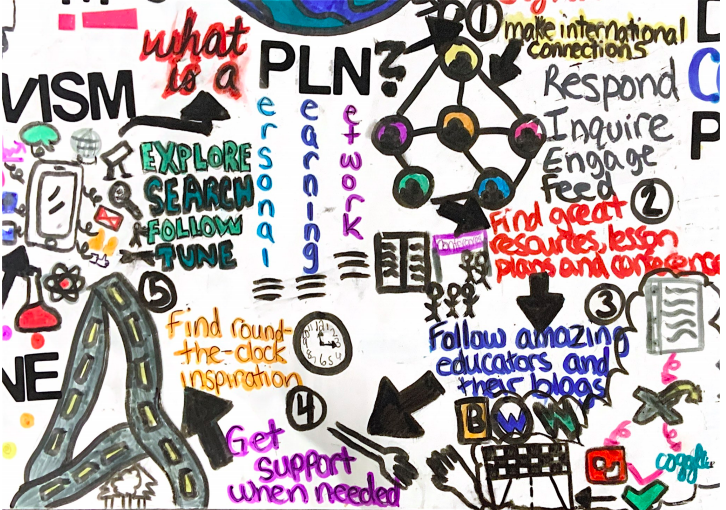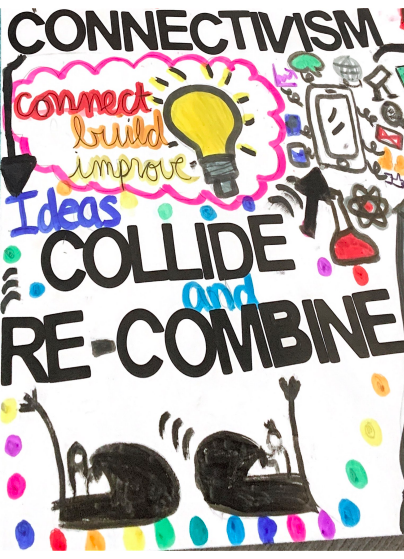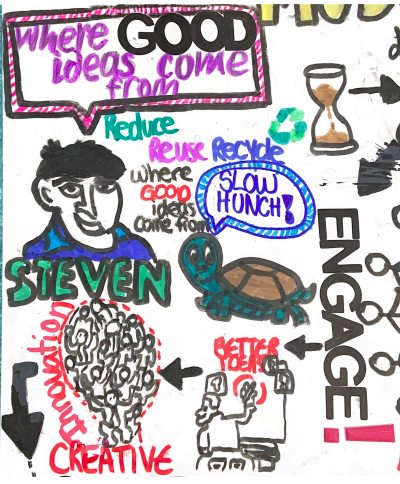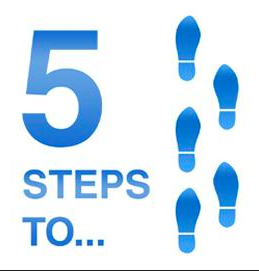
For the second multimedia reflection, I decided to create a visibly complex sketch note based on the collaborator module. This was my first time attempting anything drawing-related, nonetheless, it was a fun experience to be able to think outside the box and transfer my thoughts onto paper. I really enjoyed using vibrant colours, bubble letters, and sketches to bring the collaborator module together as one artifact. Although the principles of the collaborator module may seem simple at first glance, it is in fact more complicated than one might think to build a PLN and know exactly where and when to start. Once educated, you will begin to build trust, honesty, and openness with the network. Throughout the creation of this sketch note, I found the easiest way to comprehend and grasp the information that was being articulated was by watching the videos, listening to the TedTalks, and reading the articles on the collaborator website. It was also very helpful to go back and read my classmates perspectives on specific points in the discussion board. These learning tools are definitely something I can bring to my future classrooms to enhance a new learning experience for all. I also want to encourage students to step outside of their comfort zone such as I did with this assignment. It is important not be afraid to take risks or make mistakes because mistakes are what lead to success. In relation to that statement, when I first attempted this multimedia reflection, my entire sketch note was based on the Power of Twitter video, until further realizing it was supposed to summarize the entire collaborator unit. This mistake pushed me to work harder and create something bigger and better. Although it was a major setback and downfall to my academic progression, I did in fact learn from my errors and overall, I am happier with these results.
At first glance, this sketch note may seem overwhelming; however, the purpose of this visual aid is to direct the viewers attention to the title, the world, the twitter logo, and the brain. The title was tie-dyed to grasp the viewers attention, the world is to represent all individuals coming together from different countries in order to create and expand on ideas, the brain illustrates what humans could be capable of if we use all 7.8 BILLION brains that God has put on Earth. With that being said, every single person has something to bring to the table likewise to students in a classroom. No mind is alike, and whether the student needs differentiated learning, or an alternative strategy, we are all capable of accomplishing great things. Every single person in the videos, and articles shared a different opinion and perspective on digital tech and collaboration. With that being said, there is no right or wrong answer, and I want to push my students to think creatively.
If the reader follows the arrows from the title, they will notice the fluency -the left side is one section, the middle (PLN) is its own section following steps one through five, and the right side is one section.

The relevancy of twitter for educational purposes has a lot of controversy on whether or not it is an effective platform to use in modern classrooms. Some think it serves a digital purposes, while others tend to focus their opinions around the fact that technology is a distraction. In my case, I believe twitter to be an excellent tool if used properly. With that being said, teachers must begin by building a PLN (personal learning network) by following admins, educators, and users giving out interesting facts/ information pertinent to their daily lives. Twitter allows you to have 140 characters, which may seem like a downfall at first; however, there is a lot of richness in this. It may lead you to different paths, opportunities, or hashtags. Two of the most popular hashtags as educators are #KinderChat and #EdChat. Furthermore, it is very important to monitor hashtags and filter your feed. In 140 characters, it allows you to quickly read summarized texts about something that interests you in a specific area or discipline. Twitter is a platform that allows you to connect with some of the brightest educators in the world, allowing you to build off their ideas, resources, and thoughts. In my classroom, I would encourage the use of social media platforms -primarily Twitter in this case because I like to think of it as a modern way to follow the news. Users are always active, and providing updates from around the world, allowing us to build off each other. It is a never-ending learning cycle while giving students the freedom to be independent learners. Twitter would also allow my students to learn how to collaborate, research, and build off of others.

There is something called “Filter Bubbles”. In Eli Pariser’s TedTalk “Ideas Worth Spreading”, he says that “A squirrel dying in front of your house may be more relevant to your interests right now than people dying in Africa”. There is a shift in how education is flowing online meaning what we are clicking and posting. For example, Facebook and Google. If multiple people were to search the same thing, they would all get different results because of our tailored inquiry results. We are unaware that the combinations of algorithms are creating filter bubbles based off of 57 signals. Signals include the type of computer, type of browser etc… I drew people having a tug of war to represent what the web THINKS they want us to see but not necessarily what we NEED to see as continuous learners. One does not actually control what is put in these filter bubbles, and one is not able to see or decide what gets edited out. Instead of a balanced diet of news that make us happy, sad, uncomfortable etc… we are surrounded by filter junk food hence why I drew different types of food. Algorithms are curating the world and do not have the same power as editors. This text relates to my future classrooms because it will be important to show students ways on how they can escape filter bubbles and becoming more aware of what is happening behind screens. Making sure students are researching diverse perspectives and parts of the stories that are purposely left out in order to build a controlled and more democratic society through the aid of these filters.

In this section, I focused on the communities of practice which divides itself into three keys sections: DOMAIN, COMMUNITY and PRACTICE. Domain is a shared knowledge or skill within a specific area, the community are individuals converging and learning together, and practice is the sharing of strategies, tools, resources, and examples through a knowledge exchange. “The Role of Communities of Practice in a Digital Age” by Dr. Tony Bates describes how technology provides a wide range of tools that can support communities of practice. In my sketch note, those three key words are followed by a drawing of box that demonstrates how my students should THINK OUTSIDE THE BOX in the classroom. Furthermore, this text relates to my teaching and learning because I will further be able to educate my students on their online presence, their contributions to the better good of the community and motivate them to be willing to share their strategies. The drawing of the brain is that there are 7.8 billion people in the world so why would you only use one brain, if you had the opportunity to work with others?? Throughout this assignment, I have learnt that the more people you collaborate with, the better the ideas because everyone has an important element to add to your learning and understanding or a particular subject-matter. In classrooms, I know group work is not always encouraged or a personal favourite; however, I believe every once in awhile it expands learning and creates a favorable opportunity to build off of each other.
As a teacher candidate, I find it is crucial to continuously be outsourcing and researching diverse topics to build pedagogical practice.

One might ask… What is PLN?? I am here to tell you that a PLN is a personal learning network to help better understand what you are teaching or learning. It is a group of people that you will essentially learn from and connect with over the years. It is personal because it is ultimately up to your discretion to decide if you want to participate, collaborate, and who you want to be apart of your PLN. This will be useful fr my classroom because I can engage and follow educational pedagogies to expand my professional development to assure that I am bringing various perspectives to the table. It is not limited to global connections, but it is what makes it special. Additionally, the learning aspect is a constant cycle that connects people with similar interests which enriches your media activity on a device. The network includes platforms such as Youtube, Twitter, and the educator’s PLN. In my sketch note, I have included 5 steps to cultivate a PLN: make international connections, find great resources, lesson plans and conferences, follow amazing educators and their blogs (Word Press), get support when needed, and find round-the-clock inspiration. I have also included roads… essentially representing that your online presence can lead you to all sorts of learning opportunities and paths. I can apply this to my teaching in a way to express that the final destination is not what is important, but primarily the route, the scenery and the learning that you gained along the way.

In the video “Overview of Connectivism”, Dr. George Siemens explains the importance of collaborating. In my sketch note, I drew bumper cars to enhance the idea that ideas collide and re-combine. They bounce off of each other and take those ideas in new directions. As a teacher candidate, I will take ideas/lesson plans/resources from my fellow educators and personalize them into my own version. Similarly to the notion of science in which we connect knowledge and build to allow for large societal advancements. This analogy is why I drew an Erlenmeyer to represent that science and technology can coincide.
You’re still reading??? We made it this far. One more point, I promise.

The video “Where Good Ideas Come From” by Steven Johnson really put creativity into perspective for me. From an environmentalist perspective, he explores the recurrent patterns that are continuously occurring to be innovative. The reason I drew a turtle is because he discusses the importances of hunches that remain dormant for years to come. Over time, this information will become relevant and the hunches will begin to collide. The reason I wrote “Reduce, Reuse, Recycle” is to reinforce the idea that you will condense your thoughts, you will reuse ideas or re-formulate others ideas, and recycle them to create something better. You must ENGAGE in a system that allows these systems to multiply the formation of hunches hence why the word engage is highlighted. In my classroom, I will teach the effect that the Internet has on our brain, as well as the importance of exchanging and borrowing other peoples hunches to create something new and innovative hence why there is a lightbulb full of people. Also, the importance of finding the proper study spot, and correct strategies that work for each individual can really increase creativity. Sitting in an isolated, dark room will not be effective for all hence why I drew the empty living room. Finally, I want to make an analogy to the turtle and the hare race. The hare thought he was too good for the turtle and could have easily rushed to the finish line with his speed; however, by the turtle taking his time, he really got to learn and ended up winning the race. Ideas take time to develop, similarly to how the turtle took time to complete the race at a slower pace.
Thank you!


